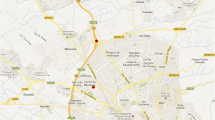Abstract
Detecting congestions on streets is one of the main issues in the area of smart cities. Regular monitoring methods can supply information about the number of vehicles in transit and thus the saturation of the streets, but they are usually expensive and intrusive with respect to the road. In recent years a new trend in traffic detection has arisen, considering the Wireless signals emitted by ‘smart’ on-board devices for counting and tracking vehicles. In this paper, two traffic monitoring methods are compared: detections using a regular Inductive Loop Detector on the road and an own Wireless Tracking System based on Bluetooth detection called Mobywit. The correlation between the day of the week and the hour with the traffic flow in a metropolitan busy street has been analysed. Assuming that our system is not able to defect all the vehicles, but just only subset of them, it is expected a causality between the results obtained using the two methods. This means, that the Bluetooth-based system can detect the same variations in the traffic flow that the regular loop detector, but having two main advantages: the tracking possibilities and a much lower cost.
Access this chapter
Tax calculation will be finalised at checkout
Purchases are for personal use only
Similar content being viewed by others
References
Arnott, R., Palma, A.D., Lindsey, R.: Does providing information to drivers reduce traffic congestion? Transp. Res. Part A Gen. 25(5), 309–318 (1991). http://www.sciencedirect.com/science/article/pii/019126079190146H
Batty, M., Axhausen, K.W., Giannotti, F., Pozdnoukhov, A., Bazzani, A., Wachowicz, M., Ouzounis, G., Portugali, Y.: Smart cities of the future. Eur. Phys. J. Special Topics 214(1), 481–518 (2012). http://link.springer.com/article/10.1140/epjst/e2012-01703-3
Carnes, P.: TraffaxInc. http://www.TraffaxInc.com/
Castillo, P., Fernández-Ares, A., García-Fernández, P., García-Sánchez, P., Arenas, M., Mora, A., Rivas, V., Asensio, J., Romero, G., Merelo, J.: Studying individualized transit indicators using a new low-cost information system. In: Handbook of Research on Embedded Systems Design. Industry and Research Perspectives on Embedded System Design, pp. 388–407. IGI Global (2014). Advances in Systems Analysis, Software Engineering, and High Performance Computing
FMM: System and method for monitoring people and/or vehicles in urban environments (May 2011). EP Patent App. EP20,080,805,357, http://www.google.com/patents/EP2325823A1?cl=en
Granger, C.: Testing for causality: a personal viewpoint. J. Econ. Dyn. Control 2, 329–352 (1980)
Kostakos, V.: Using bluetooth to capture passenger trips on public transport buses (2008). arXiv:0806.0874
Martin, P.T., Feng, Y., Wang, X., et al.: Detector technology evaluation. Technical report, Mountain-Plains Consortium (2003)
Menéndez, J.: Kilómetros a precio de Oro. DGT - Tráfico Noviembre-Diciembre, pp. 31–34 (2000)
Morrison, A., Bell, M., Chalmers, M.: Visualisation of spectator activity at stadium events. In: 2009 13th International Conference on Information Visualisation, pp. 219–226. IEEE (2009)
Nicolai, T., Kenn, H.: About the relationship between people and discoverable bluetooth devices in urban environments. In: Proceedings of the 4th international conference on mobile technology, applications, and systems and the 1st international symposium on Computer human interaction in mobile technology. pp. 72–78. ACM (2007)
Ramos, A., Ferreira, J., Barceló, J.: Intelligent urban traffic: a guide through micro modelling approaches. In: Proceedings of the IEEE International Conference on Systems, Man, and Cybernetics (SMC), pp. 2767–2772. IEEE, Anchorage, October 2011
Richard, A., Small, K.: The economics of traffic congestion. Am. Sci. 82(5), 446–455 (1994). http://www.jstor.org/stable/29775281
Rodrigue, J.P., Comtois, C., Slack, B.: The Geography of Transport Systems. Routledge, New York (2013)
Rahane, S.K., Saharkar, U.R.: Traffic congestion - causes and solutions: a study of talegaon Dabhade city. J. Inf. Knowl. Res. Civil Eng. 3(1), 160–163 (2014)
Skszek, S.L.: “state-of-the-art” report on non-traditional traffic counting methods. Technical report, Arizona Department of Transportation (2001)
TierpointLLC: Trafficnow. http://www.trafficnow.com/
Vilajosana, I.: BitCarrier. Go With the Flow. http://www.bitcarrier.com/
Acknowledgements
This work has been supported in part by project MOSOS (reference PRY142/14), which has been granted by Fundación Pública Andaluza Centro de Estudios Andaluces in the call ‘IX Convocatoria de Proyectos de Investigación’. It also has been partially funded by national projects TIN2014-56494-C4-3-P and TEC2015-68752 (Spanish Ministry of Economy and Competitiveness), PROY-PP2015-06 (Plan Propio 2015 UGR), and project CEI2015-MP-V17 of the Microprojects program 2015 from CEI BioTIC Granada.
We also thank the DGT and local council of Granada city, and their staff and researchers for their dedication and professionalism.
Author information
Authors and Affiliations
Corresponding author
Editor information
Editors and Affiliations
Rights and permissions
Copyright information
© 2016 Springer International Publishing Switzerland
About this paper
Cite this paper
Fernández-Ares, A., Arenas, M.G., Mora, A.M., Castillo, P.A., Merelo, J.J. (2016). Comparing Wireless Traffic Tracking with Regular Traffic Control Systems for the Detection of Congestions in Streets. In: Alba, E., Chicano, F., Luque, G. (eds) Smart Cities. Smart-CT 2016. Lecture Notes in Computer Science(), vol 9704. Springer, Cham. https://doi.org/10.1007/978-3-319-39595-1_5
Download citation
DOI: https://doi.org/10.1007/978-3-319-39595-1_5
Published:
Publisher Name: Springer, Cham
Print ISBN: 978-3-319-39594-4
Online ISBN: 978-3-319-39595-1
eBook Packages: Computer ScienceComputer Science (R0)




